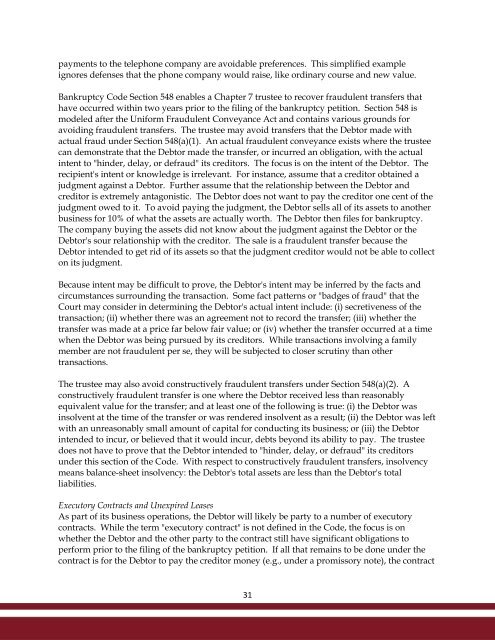Guide-for-Nonprofit-Organizations-Bankruptcy-Issues-FINAL-with-ads
Guide-for-Nonprofit-Organizations-Bankruptcy-Issues-FINAL-with-ads
Guide-for-Nonprofit-Organizations-Bankruptcy-Issues-FINAL-with-ads
- No tags were found...
Create successful ePaper yourself
Turn your PDF publications into a flip-book with our unique Google optimized e-Paper software.
payments to the telephone company are avoidable preferences. This simplified exampleignores defenses that the phone company would raise, like ordinary course and new value.<strong>Bankruptcy</strong> Code Section 548 enables a Chapter 7 trustee to recover fraudulent transfers thathave occurred <strong>with</strong>in two years prior to the filing of the bankruptcy petition. Section 548 ismodeled after the Uni<strong>for</strong>m Fraudulent Conveyance Act and contains various grounds <strong>for</strong>avoiding fraudulent transfers. The trustee may avoid transfers that the Debtor made <strong>with</strong>actual fraud under Section 548(a)(1). An actual fraudulent conveyance exists where the trusteecan demonstrate that the Debtor made the transfer, or incurred an obligation, <strong>with</strong> the actualintent to "hinder, delay, or defraud" its creditors. The focus is on the intent of the Debtor. Therecipient's intent or knowledge is irrelevant. For instance, assume that a creditor obtained ajudgment against a Debtor. Further assume that the relationship between the Debtor andcreditor is extremely antagonistic. The Debtor does not want to pay the creditor one cent of thejudgment owed to it. To avoid paying the judgment, the Debtor sells all of its assets to anotherbusiness <strong>for</strong> 10% of what the assets are actually worth. The Debtor then files <strong>for</strong> bankruptcy.The company buying the assets did not know about the judgment against the Debtor or theDebtor's sour relationship <strong>with</strong> the creditor. The sale is a fraudulent transfer because theDebtor intended to get rid of its assets so that the judgment creditor would not be able to collecton its judgment.Because intent may be difficult to prove, the Debtor's intent may be inferred by the facts andcircumstances surrounding the transaction. Some fact patterns or "badges of fraud" that theCourt may consider in determining the Debtor's actual intent include: (i) secretiveness of thetransaction; (ii) whether there was an agreement not to record the transfer; (iii) whether thetransfer was made at a price far below fair value; or (iv) whether the transfer occurred at a timewhen the Debtor was being pursued by its creditors. While transactions involving a familymember are not fraudulent per se, they will be subjected to closer scrutiny than othertransactions.The trustee may also avoid constructively fraudulent transfers under Section 548(a)(2). Aconstructively fraudulent transfer is one where the Debtor received less than reasonablyequivalent value <strong>for</strong> the transfer; and at least one of the following is true: (i) the Debtor wasinsolvent at the time of the transfer or was rendered insolvent as a result; (ii) the Debtor was left<strong>with</strong> an unreasonably small amount of capital <strong>for</strong> conducting its business; or (iii) the Debtorintended to incur, or believed that it would incur, debts beyond its ability to pay. The trusteedoes not have to prove that the Debtor intended to "hinder, delay, or defraud" its creditorsunder this section of the Code. With respect to constructively fraudulent transfers, insolvencymeans balance-sheet insolvency: the Debtor's total assets are less than the Debtor's totalliabilities.Executory Contracts and Unexpired LeasesAs part of its business operations, the Debtor will likely be party to a number of executorycontracts. While the term "executory contract" is not defined in the Code, the focus is onwhether the Debtor and the other party to the contract still have significant obligations toper<strong>for</strong>m prior to the filing of the bankruptcy petition. If all that remains to be done under thecontract is <strong>for</strong> the Debtor to pay the creditor money (e.g., under a promissory note), the contract31


